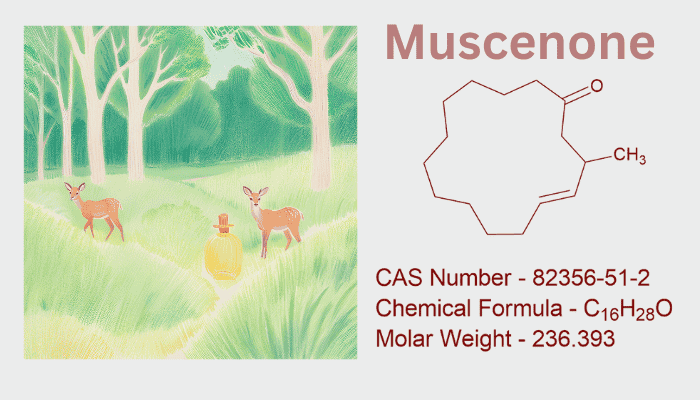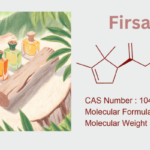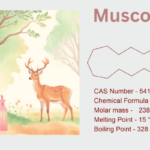1. Introduction: Muscenone—A Synthetic Marvel in Fragrance Chemistry
Muscenone, a sustainable and moral substitute for conventional animal-derived musks, is a monument to the inventiveness of contemporary chemistry. This macrocyclic ketone, which bridges the gap between luxury and responsibility, has become essential in perfumery due to its clean, velvety scent. This article examines the synthesis, olfactory properties, and revolutionary function of muscenone in the fragrance business, demonstrating how science has modernized an age-old smell.
2. Chemical Identity: The Molecular Blueprint of Muscenone
Muscenone (C₁₅H₂₆O) is a macrocyclic ketone characterized by:
- A 15-membered carbon ring with a single ketone functional group.
- Low volatility: Boiling point of ~300°C, ensuring longevity as a base note.
- Chirality: usually produced as a racemic mixture, but for specialized uses, enantiopure forms are possible.
The structure of muscenone is optimized for stability and a refined fragrance profile, which sets it apart from natural muscone, which is found in musk deer. It also lacks the strong animalic undertones of its predecessors.
3. Synthesis of Muscenone: Precision in the Lab
The manufacturing of muscenone is based on sophisticated organic synthesis methods, with an emphasis on sustainability and efficiency:
1. Ruzicka Cyclization
- Precursor: Pentadecanedioic acid or its esters.
- Process: High-temperature cyclization using catalysts like tin(II) oxide or titanium tetrachloride.
- Reaction:
HOOC-(CH2)13-COOH→Δ,SnOMuscenone+H2OHOOC-(CH2)13-COOHΔ,SnOMuscenone+H2O - Yield: ~60–70%, refined via vacuum distillation.
II. Ring-Closing Metathesis (RCM)
- Catalyst: Grubbs catalyst facilitates carbon-carbon bond formation.
- Precursor: α,ω-dienes cyclized into the 15-membered framework.
- Advantage: Reduces reliance on harsh acids.
III. Biotechnological Innovations
- Engineered Yeast: Through altered fatty acid routes, modified Saccharomyces cerevisiae generates macrocyclic ketones.
- Sustainability: Lowers carbon footprint by using bio-based feedstocks.
IV. Purification
- Crystallization: Ethanol/water mixtures yield >99% purity.
- Chromatography: Silica gel columns remove linear byproducts.
4. Natural Sources: A Synthetic Solution to an Ethical Dilemma
The necessity to substitute genuine musk from endangered musk deer (Moschus spp.) led to the creation of muscenone, which is completely synthetic. Important moral and legal motivators include:
- CITES Bans: Prohibition on trade of musk deer products (Appendix I, 1979).
- Supply Limitations: Natural musk yields only 1–2% muscone per gland, making it economically and ecologically unsustainable.
Inspiration from Nature:
- Botanical Analogs: Although some plants, such as ambrette seed (Abelmoschus moschatus), produce musky macrocyclic lactones, none of them quite mimic the structure of muscenone.
5. Odor Profile: The Scent of Subtle Sophistication
Muscenone’s aroma is celebrated for its balance of warmth and cleanliness:
- Top Notes: Crisp, airy freshness with a hint of citrus.
- Heart: Creamy, powdery warmth akin to sunlit skin.
- Base: Velvety musk underscored by whispers of white woods.
It is perfect for gender-neutral and minimalist scents because of its sophisticated profile, which steers clear of the animalic “skank” of conventional musks.
6. Uses: From Haute Couture to Household Care
Perfumery
- Base Note: prolongs the life of volatile top notes in classic scents like Glossier You and Molecule 01 by acting as a fixative.
- Accord Blending: Enhances floral (jasmine, peony) and woody (sandalwood, cedar) accords in perfumes like Le Labo Santal 33.
Cosmetics
- Lotions and Serums: Imparts a lingering warmth without greasiness.
- Deodorants: Neutralizes odors while adding a sophisticated dry-down.
Functional Products
- Laundry Detergents: Delivers a “clean linen” scent that persists through washes.
- Candles and Diffusers: Ensures even scent diffusion due to low volatility.
7. Percentage in Fragrances: The Science of Moderation
Muscenone’s potency necessitates precise dosing:
- Fine Fragrances: 0.1–1.0% (e.g., 0.3% in Byredo Mojave Ghost).
- Cosmetics: 0.05–0.2% in leave-on products like creams.
- Household Products: <0.05% for cost-effective yet impactful use.
IFRA Guidelines:
- Perfumers rarely go beyond 2% to prevent overpowering compositions, although there are no restrictions.
8. Challenges and Future Directions
Sustainability in Synthesis
- Green Catalysis: Enzymatic methods replace metal catalysts, reducing waste.
- Circular Chemistry: Byproducts repurposed for polymer or solvent production.
Regulatory Compliance
- REACH and EPA Standards: Ensures biodegradability and minimal aquatic toxicity.
9. Conclusion: Muscenone’s Olfactory Legacy
Muscenone gives contemporary scents a sustainable pulse and is the perfect example of the union of ethics and creativity. Its subtle elegance guarantees that it will continue to be a mainstay of perfumery as the industry moves toward inclusion and green chemistry. “A great musk is felt, not heard,” as renowned perfumer Alberto Morillas once said. Muscenone’s subdued resonance yet has a lot to say.










